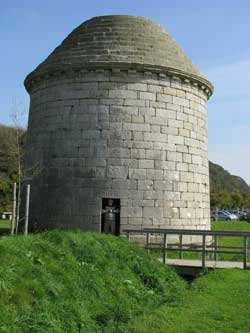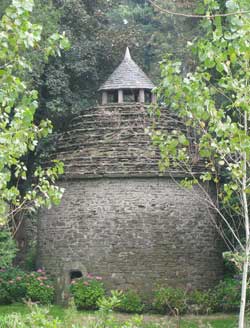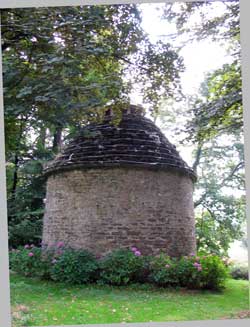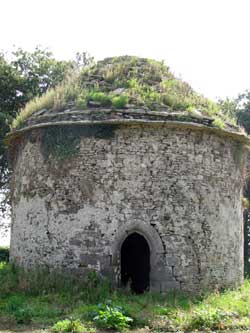
 |
 |
Kerjean Dovecote
|
|
The Kerjean dovecote, of 1599, made it onto our quick trip and must see list for two reasons. The first, of course, is that is quite a massive yet elegant example, but also because it is completely open to the public for viewing. It is part of Chateau de Kerjean a 16th century fortress that has been preserved and opened by the regional government of Finistere. The entry fee is modest and the entire grounds are certainly worth a visit, but for the ardent dovecote enthusiast, not even an entry fee is required as the dovecote lies outside of the main fortress wall. This massive dovecote told you all about the power of the inhabitants, without subtlety, as you passed by it towards Kerjean's main entry gate. The chateau was constructed by Louis Barbier and replaced even an older manor, upstaging all of the area's noble residences. Ah! how far we have come. It remained with the well connected Barbier family until the time of the Revolution, when Suzanne and her sister were dispatched, and the property confiscated by the state.
The dovecote, with one glaring omission, has been wonderfully restored, as you can see in the small photos on the left. The stones of both the walls, base and even roof are massive. The overhanging roof line is supported by large stone corbelets. The wall is nearly four feet thick, and the ogee-shaped base is even larger. The interior is also in the same scale, as you will notice from the close-up of the of the nearly 1,000 nest holes laid out as 29 rows extending all the way to the floor with either 34 or 35 nests per row. There is a landing ledge at every 6th row. The nest holes are quite unique in design. While the bulbous interior alternates by row from left to right, maintaining the general L-shape, the entryway to each nesthole is set at an angle as well, becoming more of an L in shape. As noted, the roof is also of large stones, and from the outside arranged as stair steps, but in the interior they are quite smooth, making the interioi conical. The one glaring omission is that of the potence. While the stones for the potence's base remain, the potence itself does not. The restorers may have been struck with the same dilemma I noticed. I could not see where the potence would have attached to the roof. So they may have decided to leave it out rather than err in its recreation.
 |
 |
Keruzoret dovecote
|
|
The 15th century dovecote and manor of Keruzoret are on private property, but may be viewed with just the most minor of restrictions. You are requested not to drive down the lane to the house, but rather to leave your vehicle by the gate and walk down the drive to the dovecote. The property of Keruzoret always remained in the same family through all the centuries, even including after the Revolution. The stroll is only about 1,000 feet, and rewards you with a great view of the manor, which is a delight in itself. To find the manor, and of course the dovecote, travel north out of Plouvorn on a road immediately west of the church for .6km, going through a small roundabout. The left turn to the manor is sign posted Keruzoret. Drive up this road to the gates, where there is a place to park and start your walk.. The dovecote lies on the right outside of the manor's gates.
The dovecote is rather small, with only slightly over 600 nestholes. While of rather standard design, including the diameter, it is not as high as most, providing only enough space for 20 rows. It is made entirely of stone, with the exception of the cupola, which is partly of wood. The nestholes' bulbous interiors alternate by row going from left in one row to right on the next. No landing ledges are provided. The door is a nice decorative element, being rather nicely carved. The roof, while being stone stair stepped on the exterior, has rather smooth surface on the interior. It also provided double duty, with the ample overhang protecting the walls from the weather as well as preventing predators from gaining easy access into the cote. The dovecote most certainly had a potence in its day, as attested by the stone base and the main potence pole mount hole in the base stone. If you look closely, you can see the hole n the stone for the center potence pole as well as the mark left by the outer edge of the potence as it turned on the stone.
 |
 |
| Kergournadeac dovecote |
|
We learn from Dr. Jean Auffret that Ker-Gour-Na-Deac' H means the place of the man who does not flee. This name comes from the legend of the dragon of the island of Batz. The story has three protagonists: the dragon, being the monster of Loc Ness, Saint-pol Aurelien, and a young soldier of Cleder with more courage then mortal man should have. These two men, Saint Aurelien protected with only church vestments as armour and a stick, and the young Cleder soldier with only a sword blessed by the Saint, ended the horrible scourge of the dragon.
In reward for his courage, the Count Withur gave to the young soldier a field that became known as Ker-Gour-Na-Deac' H, where the castle and dovecote now lay. The castle goes back to 1620, but the dovecote is more recent.
This is not a large dovecote, having an interior diameter of only 20 feet, supporting 23 rows with between 23 to 25 nestholes per row, making a total count of just under 600. They were laid out in the standard checkerboard pattern, without landing ledges. One rather unusual element is the mortar or plaster that was used to lay the stones. The mortar/plaster was also used on the outside wall to provide a smooth surface to the exterior wall, which was probably a decorative touch. A smooth exterior wall might have made it difficult for predators to climb the cote, but there is a sufficient roof overhang to keep them from gaining entry. The wall thickness appears to be the standard for its day,of about 4 feet. The door is rather nicely shaped, and stands 5 feet 6 inches tall, making the entryway rather ample. The potence stone appears to have been re-used as a grinding stone, finding new life after serving as the base for the potence ladder.
Do a little casting about on these very little roads to find this dovecote. There are many roads that go in every direction, but the dovecote is clearly visible in a field to the north of the ruined chateau. As you can see it is well worth the search.
DAY |
||||||||||||||||||
| 00 | 01 | 02 | 03 | 04 | 05 | 06 | 07 | 08 | 10 | 11 | 12 | 13 | 14 | 15 | 16 | 17 | 18 | |